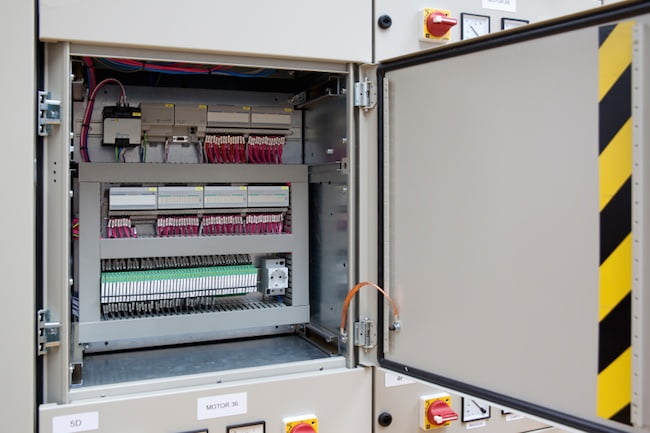Optimizing Space & Keeping Cool with Control Panels

Electrical control panel builders know that the cost of the bare control panel represents a significant percentage of the total material cost of the completed electrical enclosure. Not only that, but a larger panel takes up more floor space, uses more material and is heavier than a small panel. It’s for these reasons there’s a natural tendency to use smaller control panels whenever possible.
However, components in smaller panels are more tightly packed, and unless care is taken to deal with the increased thermal load, a smaller control panel may overheat. Here are some ways to avoid that risk and optimize space.
Why Tighter Packing Means More Heat
In a tightly packed electrical panel, the physical clearances between adjacent components are reduced and the convection of heat from one component to the other is increased. Also, there is less space inside the panel for heat to dissipate and consequently component temperatures may rise.
Because a smaller panel has less surface area, heat dissipation through the cabinet sides is reduced, exacerbating the situation. Cooling systems also suffer because the tighter packing means it’s more difficult to circulate cooling air around the components, so less heat is removed.
Engineer Cooling At Design Stage
With a small, tightly packed control panel, The need to allow for enclosure cooling at the control panel design stage is much greater. It is at this stage that the component layout can be optimized to minimize heating effects and to identify the optimal enclosure cooling method. Different cooling options can be analyzed using online enclosure temperature management calculators and the benefits of different panel sizes easily assessed.
Although there are numerous factors to be considered, three stand out as being particularly important. These are the type of enclosure cooling, component selection, and provision of natural air circulation channels.
Enclosure Cooling Methods
The use of a smaller, densely packed enclosure may result in a significant heat load, and some form of forced enclosure cooling will most likely be required. If the ambient air temperature is moderate, it’s possible that filtered fan packages will be adequate, but if the environment is dirty or polluted, a closed loop cooling solution, such as a heat exchanger, is preferable.
If the environment is hot, serious consideration should be given to enclosure air conditioning because a properly sized unit will ensure that the enclosure is maintained at the desired temperature and eliminate the risk of equipment failure due to overheating.
Equipment Selection
Care should be taken to select electrical equipment from reputable manufacturers and, in particular, to look for units with high thermal efficiency that generate less heat. If variable frequency drives are used, the electrical efficiency of the drives at the desired load should be carefully checked to limit the amount of heat dissipated from the drives.
It is also worth evaluating the physical sizes and cross sections of the electrical components. Some manufacturers make devices with a relatively small footprint and a slightly higher profile that are more suited to installation in a small control panel.
Uncluttered Airways
It is important to ensure that there are natural airways in the enclosure to direct the cooling air to all points in the enclosure. Cable harnesses should be located away from the air passages. It is a good idea to install them at the side of the enclosure away from the cooling air inlet and outlet. Ensure that devices that generate a lot of heat are as close to the air conditioner as possible and that the hot air discharged by these devices does not interfere with other equipment.
Choose Compact Cooling Solutions
Match the enclosure cooler profile to the control panel. Powerful compact air conditioners and air to air heat exchangers are available that take up very little space. However, it’s vital to ensure that there’s adequate space for the discharge of warm air and manufacturer’s recommendations are followed.
As long as adequate enclosure cooling is provided, compact control panels save space even when the size of the cooling unit is factored in; such units often cost less than full size control panels. If you need further information, speak to our Support Team and let them show you how Thermal Edge compact air conditioners and air to air heat exchangers can reduce your control panel costs.

